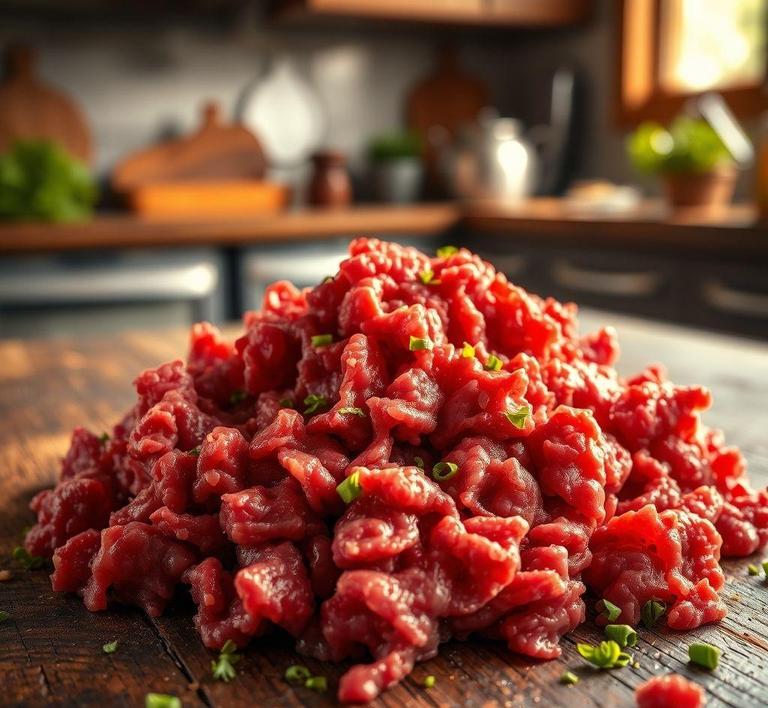When it comes to refreezing fresh ground beef, it’s a topic that often leaves people scratching their heads. While it might seem like a simple task, there are important things to consider in order to maintain both food safety and quality. You might be wondering if it’s safe to refreeze beef after it’s been thawed, and how it affects the texture and flavor. In this guide, we’ll dive into the best practices for refreezing ground beef so that you can avoid any mishaps and enjoy your meals without worry. From thawing methods to proper storage techniques, we’ve got you covered on everything you need to know about refreezing fresh ground beef!
Can You Refreeze Fresh Ground Beef?

Yes, you can refreeze fresh ground beef-but under certain conditions. The key factor that determines whether refreezing is safe or advisable lies in how the ground beef was handled after its initial thawing. If the beef was defrosted in the refrigerator and kept at a safe temperature (below 40°F or 4°C), it is perfectly safe to refreeze it. However, if it was thawed on the countertop, in warm water, or in the microwave, then refreezing is not recommended due to the increased risk of bacterial growth during these processes.
The United States Department of Agriculture (USDA) guidelines state that meat thawed in the refrigerator can be safely refrozen within 1-2 days. This assumes the beef hasn’t reached the temperature danger zone (40°F to 140°F), where bacteria multiply rapidly. So, timing and temperature control are crucial.
How To Refreeze Fresh Ground Beef?
If your ground beef meets the safety criteria for refreezing, you can take a few extra steps to preserve its quality and ensure that it remains safe for future use.
-
Check for Freshness:
Before refreezing, examine the beef for any signs of spoilage. If it smells sour, feels slimy, or has changed color significantly (grayish-brown throughout instead of pink/red), do not refreeze or consume it.
-
Repackage Smartly:
Instead of refreezing it in its original supermarket tray (which may not be airtight), wrap the beef tightly in plastic wrap, aluminum foil, or vacuum-seal it. Then, place it in a freezer-safe zip-top bag or airtight container. Remove as much air as possible to prevent freezer burn.
-
Label Clearly:
Note the date of refreezing and whether the meat has been previously frozen and thawed. This helps you use it within a safe window-ideally within 2 to 3 months for best quality.
-
Freeze Quickly:
Make sure your freezer is set to 0°F (-18°C) or lower. A rapid freeze helps preserve texture and flavor. Spreading the meat flat in a thin layer helps it freeze faster.
-
Thaw Properly Next Time:
For any subsequent thawing, always use the refrigerator method again to ensure it’s safe to cook or freeze once more.
Quality Impact
While refreezing ground beef is generally safe if done correctly, it does come with some trade-offs-primarily in terms of texture and moisture retention.
When beef is frozen, the water inside the muscle fibers expands into ice crystals. These crystals can rupture the cell walls of the meat. Upon thawing, the broken fibers release moisture, which is why refrozen and rethawed beef can often be drier and grainier in texture.
Furthermore, repeated freeze-thaw cycles can cause:
- Loss of juiciness during cooking.
- Slight changes in flavor, often described as duller or more metallic.
- Difficulty in forming cohesive patties or meatballs, as the binding structure of the meat can be weakened.
However, if the meat was very fresh when first frozen, and it’s handled meticulously through the freezing and thawing process, many of these impacts can be minimized. Using the refrozen beef in dishes that involve sauces or broths-like chili, spaghetti sauce, or shepherd’s pie-can help mask any texture or flavor degradation.
Refreezing fresh ground beef is not only possible-it’s safe, provided that the meat has been properly thawed in the refrigerator and hasn’t lingered in unsafe temperature zones. That said, while safety can be ensured through good practices, the culinary quality may not remain untouched. Expect some compromise in texture and moisture, though not necessarily in taste, if care is taken.
Ultimately, the decision to refreeze should balance safety, convenience, and culinary goals. For example, if you plan to use the beef in a dish with robust seasonings or a rich sauce, the textural changes may not matter much. On the other hand, if you’re preparing burgers or meatloaf where texture and juiciness are paramount, it might be better to cook the beef and freeze the cooked product instead.
Is It Safe To Refreeze Fresh Ground Beef?
Refreezing fresh ground beef can be done safely-but it’s not without conditions. The key lies in how the meat was handled after its initial thaw. According to USDA guidelines, ground beef that has been thawed in the refrigerator is generally safe to refreeze, assuming it has not sat out at room temperature for more than two hours (or one hour in temperatures above 90°F).
When you freeze meat, ice crystals form inside the muscle fibers. If thawed properly (slowly and at a safe temperature), the structural damage to the meat is minimal. But if the meat is refrozen after partial cooking or exposure to room temperature, both its quality and safety can be compromised. Harmful bacteria such as E. coli and Salmonella can flourish if ground beef is mishandled, and freezing does not kill bacteria-it merely puts them into dormancy. Once the beef is thawed again, the bacteria "wake up" and resume multiplying, which could make the food unsafe to eat.
So yes, refreezing is safe-under the right conditions. Temperature control is everything. If you thawed your ground beef in the fridge and kept it below 40°F, you’re likely in the clear.
Signs That Fresh Ground Beef Should Not Be Refrozen
Before reaching for the freezer door, pause and give your ground beef a quick inspection. If you spot any of the following warning signs, refreezing is a bad idea-and consuming it may be dangerous:
-
Odd or Sour Odor:
Fresh ground beef should have a mild, iron-like smell. A strong sour, ammonia-like, or rancid odor is a sign that bacteria have begun to break down the proteins, making the meat unsafe.
-
Slimy or Sticky Texture:
Healthy beef has a firm yet pliable texture. If it feels tacky or slimy to the touch, that slickness is likely due to bacterial growth, and refreezing it could just prolong spoilage.
-
Brown or Gray Discoloration (With a Foul Odor):
A little browning is normal due to oxidation, especially around the edges. However, if the entire portion has turned a dull gray or greenish hue-especially accompanied by a smell-it’s time to toss it.
-
Unexplained Time at Room Temperature:
If the ground beef has sat out for more than two hours (or one hour on a hot day), bacteria could have grown to unsafe levels-even if it looks and smells fine.
Common Refreezing Mistakes
Even with the best intentions, many home cooks inadvertently make mistakes when trying to save ground beef for later use. Here are the most common pitfalls-and how to avoid them:
-
Refreezing After Partial Cooking:
Partially cooked meat has an uneven internal temperature, which may allow bacteria to survive and multiply. Never refreeze meat that hasn’t been fully cooked or properly cooled.
-
Thawing on the Counter:
Thawing ground beef on the countertop is a major no-no. The outer layer warms much faster than the center, creating a breeding ground for bacteria. Always thaw in the refrigerator, microwave, or under cold water.
-
Refreezing Too Many Times:
Repeated freeze-thaw cycles degrade texture and flavor. Each cycle damages muscle fibers, resulting in dry, crumbly, and less palatable meat. Limit refreezing to just once, if possible.
-
Not Labeling the Package:
You might think you’ll remember when you last froze it, but memory is fickle. Always label your package with the date it was originally frozen and the date it was thawed, so you can track its freshness with confidence.
Tips And Tricks
Maximize safety and flavor with these time-tested tips and clever storage tricks:
-
Freeze in Portions:
Divide fresh ground beef into smaller, meal-sized portions before freezing. This not only speeds up thawing but also reduces the need to refreeze leftovers.
-
Use Airtight Packaging:
Air exposure causes freezer burn and flavor loss. Use vacuum-sealed bags or wrap tightly in plastic wrap followed by aluminum foil. For best results, expel as much air as possible.
-
Freeze Quickly:
The faster the beef freezes, the smaller the ice crystals that form-helping preserve texture. Set your freezer to its coldest setting (0°F or lower) for 24 hours after adding new meat.
-
Label with Detail:
Include the original freeze date, the thaw date, and any cooking instructions. ‘Ground beef – thawed 5/17 – refreeze by 5/19’ provides vital info at a glance.
-
Cook Thoroughly After Refreezing:
Once you finally prepare your refrozen beef, ensure it reaches an internal temperature of 160°F to kill any lurking bacteria.
Conclusion
In the hustle of everyday life, it’s common to thaw ground beef with dinner plans in mind-only to have those plans change. The good news is, if your meat was thawed safely in the fridge and hasn’t lingered at unsafe temperatures, refreezing is not only permissible-it’s a smart way to reduce waste and stretch your grocery dollar.
Still, the golden rules remain: Trust your senses. Use proper storage methods. Avoid repeated thawing cycles. With just a little attention to handling, you can safely refreeze ground beef without compromising safety or quality.
So the next time dinner takes a detour, you’ll know exactly what to do-and what to watch out for. Your freezer can be your best culinary ally, so long as you use it wisely.

